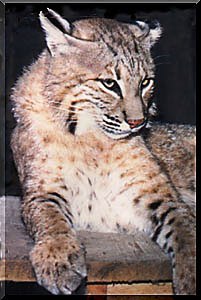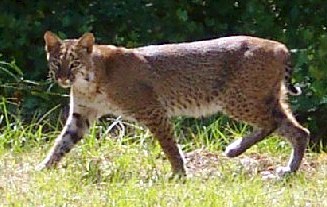Discover Florida Nature
It's time to explore the natural Florida


|
|
|
|
|
 The
bobcat (Lynx rufus) is equipped with razor-sharp claws,
needle-like teeth, and the strength to make good use of these weapons.
About the size of a medium-sized dog, male bobcats average 39 inches in
length and weigh about 24 pounds, while females are closer to 36 inches
in length and 15 pounds in weight. The bobcat is so named because of
it's 'bobbed' tails, which are usually 5-6 inches, although tails as
long as eighteen inches have been recorded! The
bobcat (Lynx rufus) is equipped with razor-sharp claws,
needle-like teeth, and the strength to make good use of these weapons.
About the size of a medium-sized dog, male bobcats average 39 inches in
length and weigh about 24 pounds, while females are closer to 36 inches
in length and 15 pounds in weight. The bobcat is so named because of
it's 'bobbed' tails, which are usually 5-6 inches, although tails as
long as eighteen inches have been recorded! The bobcat fur is short, soft, and dense. Its color is dark brown with black spots and bars most visible along the sides and legs. There have also been rare sightings of melanistic, or black bobcats in Floridian nature. In 2007 wildlife officials were able to capture a rare black bobcat and take blood and DNA samples from it before returning it to the wild. The backs of the bobcat ears are white with a black outline. Their underparts are generally white. Bobcats are common in every county in Florida and should not be confused with a Florida Panther. The easiest way to tell the two cats apart is the famous "bobbed tail "of the bobcat. I encountered a very large bobcat while walking through the woods on a nature walk. I had stopped to enjoy the view, looking down on an old limestone pit and when I got up and turned the next corner a bobcat was standing in the path. The cat looked as surprised to see me as I was to see her. She was a large cat, coming up to my waist in height, but there was no mistaking the bobbed tail which was about half the length of a normal one. She was gracious enough to go behind a bush and allow me to pass by without an incident to either of us. Due to its abundance in Florida, the bobcat is not listed as endangered nor threatened. However, it is classified as a fur-bearing game animal by the Florida Game and Freshwater Fish Commission and can only be hunted during certain months of the year. In recent surveys, Florida was the only state to show a decline in bobcat numbers in recent years. Bobcats are territorial and solitary. Bobcats of the same sex do not share the same home range. A male bobcat will not allow another male to use its home range. Likewise, a female bobcat will not tolerate another female within her range. However, there is some overlap in range boundaries between same-sexed neighbors. The degree of overlap varies from area to area and by sex. Males do allow females to use their ranges and vice-versa. Because of this territorial behavior, bobcat property is partitioned in much the same way as humans own and occupy property. The bobcat is equally at home in deep forest, swamps, and hammock land. Thick patches of saw palmetto and dense shrub thickets are important as den and resting sites in Florida. Bobcats have a territorial range of five or six square miles and generally cover their territory in a slow, careful fashion. Home ranges are elliptical in shape and boundaries often follow roads, streams, or other natural contours. Boundaries, as well as range sizes, do shift seasonally. For instance, male bobcats tend to expand their boundaries during the breeding season in order to maximize the opportunities to find a mate. When rearing young kittens, female bobcats often appear to use less area because of the need to tend to their litter.  Bobcats
have retractable claws like house cats. This is a good way to tell the
difference between a bobcat track and that of a dog since they are
similar in size. Bobcats put their back feet in the same place where
their front feet stepped so as not to disrupt the surroundings any more
than necessary. An extremely efficient hunter, the bobcat, like most
felines, hunts by sight and usually at night. Like most carnivores,
bobcats possess teeth which are specialized for the acquisition and
consumption for prey. The bobcats teeth are extremely effective in
severing the spinal cord of small prey or delivering severe puncture
wounds to a person or an attacking animal. Bobcats will eat just about
anything that moves, but mammals are by far the most important group of
prey animals. In Florida, the
eastern cottontail, marsh rabbit,
cotton rat, and an occasional young
white-tailed deer are the primary prey species. By feeding on these
animals, the bobcat provides a necessary control on their populations.
Since Florida is also an important wintering habitat for migrating
birds, the bobcat’s winter diet reflects this abundance and includes
ground-dwelling birds such as towhees,
robins, catbirds and thrashers. Bobcats
have retractable claws like house cats. This is a good way to tell the
difference between a bobcat track and that of a dog since they are
similar in size. Bobcats put their back feet in the same place where
their front feet stepped so as not to disrupt the surroundings any more
than necessary. An extremely efficient hunter, the bobcat, like most
felines, hunts by sight and usually at night. Like most carnivores,
bobcats possess teeth which are specialized for the acquisition and
consumption for prey. The bobcats teeth are extremely effective in
severing the spinal cord of small prey or delivering severe puncture
wounds to a person or an attacking animal. Bobcats will eat just about
anything that moves, but mammals are by far the most important group of
prey animals. In Florida, the
eastern cottontail, marsh rabbit,
cotton rat, and an occasional young
white-tailed deer are the primary prey species. By feeding on these
animals, the bobcat provides a necessary control on their populations.
Since Florida is also an important wintering habitat for migrating
birds, the bobcat’s winter diet reflects this abundance and includes
ground-dwelling birds such as towhees,
robins, catbirds and thrashers.In Florida, bobcats breed from August to March with the peak in February and March. Courtship and mating usually last one to two days. There are known instances where bobcats will breed with feral cats. During this time, the male and female bobcat will travel, hunt, and eat together. Except when adults come together to mate, or when a female is raising kittens, each bobcat remains alone throughout its life. The average litter size is two to three kittens, and they are born after a gestation period of 50 to 60 days. The bobcat kitten's fur is spotted when they are born and as they get older the spots fade into light black streaks. The kittens eyes do not open until about nine days old. The young are weaned in about two months. From about five months on, the dam, or mother bobcat, will teach her kittens how to hunt for food. From eight to eleven months of age, the dam will abandon her kittens or evict them from her home range. Most Floridians have never seen a bobcat, though the fringes of suburbia continue to move ever closer to its habitat. Swift and secretive, hunting mostly at night, bobcats are the most discreet of neighbors and an integral part of Florida’s wildlife community. |
|
|
Advertise | Privacy Statement | Contact | Alaska Nature | Michael Arnold Art| Dog Encyclopedia | Dog Encyclopedia| |
|